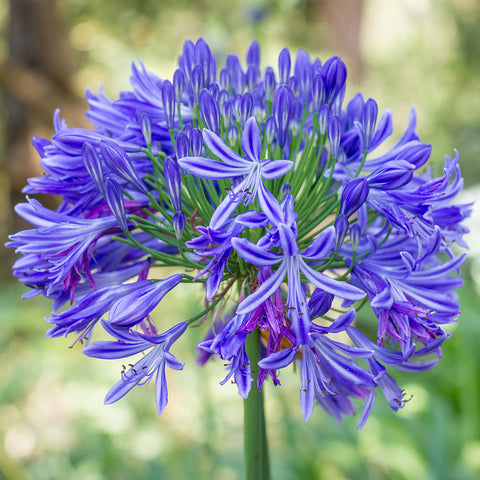Mastering the Art of Agapanthus Care: Important Actions for Healthy And Balanced Growth and Lively Blooms
In the realm of gardening, the farming of agapanthus stands as a gratifying endeavor for those that look for to nurture these stylish blooming plants. With their striking blooms and graceful foliage, agapanthus has actually recorded the attention of garden enthusiasts worldwide. However, attaining optimal growth and dynamic blooms calls for a nuanced approach that encompasses different necessary steps. From choosing the ideal selection to understanding pruning techniques, the journey towards cultivating prospering agapanthus plants is diverse and holds the vital to opening the full capacity of these organic gems.

Choosing the Right Agapanthus Range

When picking the best Agapanthus variety for your garden, consider aspects such as environment viability, blossom color, and growth habit. Agapanthus, generally called Lily of the Nile or African lily, comes in a selection of shades ranging from tones of purple and blue to white. Choose a blossom shade that enhances your existing garden combination to produce a harmonious landscape. Furthermore, think about the climate in your area to ensure the Agapanthus selection you choose can grow in your details conditions. Some selections are much more tolerant of chilly temperatures, while others choose warmer climates. Comprehending the growth routine of different Agapanthus varieties is essential for appropriate placement within your yard. Some selections have a clumping growth practice, suitable for borders or containers, while others have a more spreading nature, suitable for ground cover or mass growings. By meticulously reviewing these elements, you can pick the best Agapanthus variety to improve the beauty of your yard.
Perfect Growing Problems
Considering the optimum ecological requirements is vital for effective Agapanthus cultivation. Agapanthus plants are sensitive to cold temperatures and need to be secured from frost throughout wintertime months.
To ensure healthy and balanced growth and vivid flowers, plant Agapanthus light bulbs at a depth of about 2-4 inches and room them 8-12 inches apart. Mulching around the base of the plants assists retain moisture and subdues weed development.
Watering and Feeding Tips
Maintaining appropriate wetness degrees and offering crucial nutrients are vital components in the treatment program for Agapanthus plants. When it comes to watering Agapanthus, it is critical to strike a balance. These plants prefer regularly wet dirt but are at risk to root rot if overwatered.
Fertilizing Agapanthus is important for advertising healthy growth and prolific flowers. Apply a well balanced fertilizer, such as a 10-10-10 formula, in the early springtime as new development emerges. Repeat this application every 6-8 weeks throughout the growing period. Prevent too much fertilization, as it can result in rich vegetation at the cost of blooms. Always adhere to the manufacturer's directions for correct dilution and application click this site methods. By following these watering and feeding ideas, you can ensure your Agapanthus plants grow and produce vibrant, resilient blossoms.
Trimming Strategies for Agapanthus
Trimming Agapanthus plants at the proper times and with proper methods is vital for keeping their health and promoting optimum development and flowering. The perfect time to prune Agapanthus remains in late winter or early spring before new growth arises. Beginning by getting rid of any kind of dead or yellowing fallen leaves near the base of the plant. Cut them as close to the ground as possible without harming the arising shoots.
For flowered stems, wait till the blossoms have withered and afterwards trim them back to the base. This not just cleans the plant's look but additionally encourages the advancement of new blossom buds. Deadheading invested flowers can also redirect the plant's energy right into creating more flowers as opposed to establishing seeds. Nevertheless, if you desire to gather seeds for breeding, leave some blossoms to dry and mature on the plant.
Remember to utilize clean, sharp linked here devices to make precise cuts and reduce the danger of presenting diseases. Agapanthus. Routine pruning will certainly help keep your Agapanthus looking healthy and balanced and cool while making certain a bountiful display of beautiful blossoms
Dealing With Typical Bugs and Diseases
After making certain correct pruning techniques for Agapanthus, it is necessary to address usual insects and conditions that can impact the health and vitality of these plants. Agapanthus plants are generally sturdy however can still succumb to specific issues. One usual parasite that influences Agapanthus is the Agapanthus gall midget. This tiny, orange fly lays its eggs in the vegetation, causing altered development and flower buds that stop working to open. To combat this parasite, prune and damage any kind of damaged plant components and consider making use of insecticidal soap.
Additionally, Agapanthus plants can endure from root rot if they are planted in inadequately draining soil. By being cautious and taking timely activity versus insects and illness, you can aid your Agapanthus plants thrive and create vivid blossoms. Agapanthus.

Conclusion
In verdict, understanding the art of agapanthus care involves selecting the appropriate range, providing optimal planting conditions, correct watering and feeding, proper trimming techniques, and addressing usual pests see post and conditions. By complying with these crucial steps, you can ensure healthy development and vibrant flowers for your agapanthus plants. Bear in mind to on a regular basis keep an eye on and preserve your plants to promote their total well-being and long life.
To guarantee healthy development and lively flowers, plant Agapanthus bulbs at a depth of regarding 2-4 inches and area them 8-12 inches apart. By complying with these watering and fertilizing suggestions, you can guarantee your Agapanthus plants prosper and create vibrant, resilient blossoms.
One usual pest that influences Agapanthus is the Agapanthus gall midge. In addition, Agapanthus plants can experience from root rot if they are planted in poorly draining pipes dirt. By following these essential steps, you can make certain healthy growth and vibrant blossoms for your agapanthus plants.